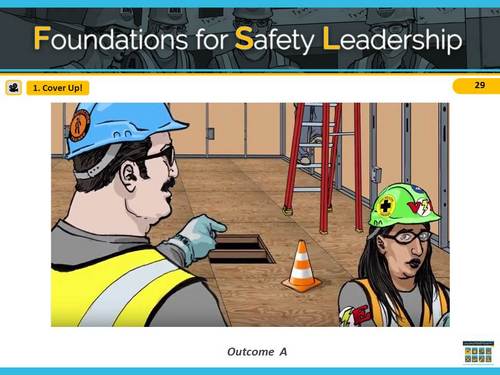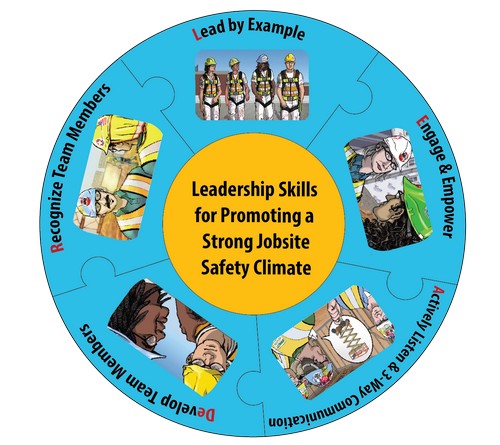By Dr. Linda M. Goldenhar
Research tells us that “safety climate”— workers’ perceptions of how well safety policies, procedures and practices are implemented on the jobsite — is reflected in jobsite injury and near miss rates. You can’t create a positive safety climate on your own, though: your foremen and lead workers are essential for creating a strong safety climate by being effective jobsite safety leaders.
 The research on safety climate consistently shows that a more positive safety climate leads to fewer injuries. Several studies show that safety leadership training for supervisors leads to better safety climate, which then leads to reduced injury. Unfortunately, there has been a shortage of safety leadership programs that can be used to educate these frontline leaders.
The research on safety climate consistently shows that a more positive safety climate leads to fewer injuries. Several studies show that safety leadership training for supervisors leads to better safety climate, which then leads to reduced injury. Unfortunately, there has been a shortage of safety leadership programs that can be used to educate these frontline leaders.
To help address this training shortage, The Center for Construction Research and Training, a nonprofit research institute supported with funding from the National Institute for Occupational Safety and Health, worked with industry and research partners to develop the “Foundations for Safety Leadership (FSL)” course. In January 2017, OSHA approved the FSL as an official elective for the OSHA 30-hour training curriculum. The course can also be taught separately as part of company foreman or supervisor training.
In the first part of the two-and-a-half hour program, foremen learn about skills that effective safety leaders use on the jobsite. Specifically, the leaders lead by example when they “walk the talk” when it comes to safety, and make safety a core value, even in the face of production and schedule challenges. They engage team members by encouraging and empowering their crews to identify, report and remove hazards.
- They actively listen when they listen to hear what team members are saying, rather than listening to come up with an answer
- They practice three-way communication when they ask crew members to repeat instructions to make sure everyone is on the same page
- They develop team members by teaching, coaching and providing them with timely and constructive feedback.
- They recognize team members by privately or publicly acknowledging them when they go above and beyond for safety
The second portion of the program drives home the points learned in the first section by providing students with the opportunity to work through one or more of the seven dynamic scenarios that present realistic safety situations on a construction site where characters are seen putting (or not putting) the skills into practice. Each scenario first presents a safety situation on a jobsite, which is followed by two different outcomes showing the foreman or superintendent using (or not using) one or more of the leadership skills.
 For example, in one of the scenarios, a fall hazard is created in an inside work area because of an uncovered floor opening. In the first outcome, the foreman fails to use any of the leadership skills when he tells an apprentice electrician to cover the hole and the end result is not ideal. While in the second outcome, he uses three-way communication to make sure the apprentice understands what he wants her to do and by when he wants it done, which leads to a much better outcome. Instructors can present the videos either by playing a video, reading a script or using a role-playing exercise.
For example, in one of the scenarios, a fall hazard is created in an inside work area because of an uncovered floor opening. In the first outcome, the foreman fails to use any of the leadership skills when he tells an apprentice electrician to cover the hole and the end result is not ideal. While in the second outcome, he uses three-way communication to make sure the apprentice understands what he wants her to do and by when he wants it done, which leads to a much better outcome. Instructors can present the videos either by playing a video, reading a script or using a role-playing exercise.
Foremen who participate in the FSL training and put the skills learned into practice can help deliver:
- A sustained positive safety climate on your jobsites
- Reduced hazards and injuries
- Increased morale and sense of teamwork
- Increased productivity due to more effective communication
Dozens of construction firms have already adopted the FSL and are reporting benefits. ”I see the foremen more likely to explain things and take more time to make sure there is understanding between the employees and their leadership,” said Steve Bell, safety director for civil contractor Fiore & Sons.
Richard Coakley, corporate safety director at Gaston Electrical, has seen similar positive changes on the jobsite. “Foremen seem a lot more engaged with the employees now. So they’re actually getting input, ‘How can we fix this?’ So somebody brings something to them and they come up with ideas on how to get it corrected.”
FSL can be incorporated into your own safety training efforts, whether as part of an in-house OSHA-30 or as a stand-alone program. All of the training materials (PowerPoint presentation, animated videos, instructor teaching guide and student materials) are available free of charge and can be downloaded at https://www.cpwr.com/foundations-safety-leadership-fsl. If using an outside firm to deliver OSHA-30 outreach training to your foremen, ask them to include the FSL as one of the electives.
The construction industry has stated loud and clear that they want their foremen and lead workers to possess the skills necessary to be effective jobsite safety leaders. The Foundations for Safety Leadership module has demonstrated that it can meet the industry’s needs.
Dr. Linda M. Goldenhar, director of research and evaluation at CPWR, led the team that developed the FSL. She can be reached at lgoldenhar@cpwr.com.
Editor’s Note: CPWR – The Center for Construction Research and Training is supported by the National Institute for Occupational Safety and Health under grant OH009762. The contents of this article are solely the responsibility of the author and do not necessarily represent the official views of NIOSH.



 Join our thriving community of 70,000+ superintendents and trade professionals on LinkedIn!
Join our thriving community of 70,000+ superintendents and trade professionals on LinkedIn! Search our job board for your next opportunity, or post an opening within your company.
Search our job board for your next opportunity, or post an opening within your company. Subscribe to our monthly
Construction Superintendent eNewsletter and stay current.
Subscribe to our monthly
Construction Superintendent eNewsletter and stay current.